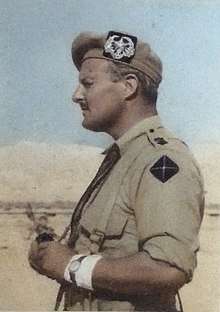Duncan Carter-Campbell of Possil
Lieutenant Colonel Duncan Maclachlan Carter-Campbell of Possil (8th of Possil) OBE[1] (5 December 1911 – January 1990), son of Major-General George Tupper Campbell Carter-Campbell C.B., D.S.O,[2] was a British Army Colonel during the 1950s.[3]
Lieutenant Colonel Duncan Carter-Campbell of Possil OBE | |
|---|---|
 | |
| Born | 5 December 1911 The Island of Malta |
| Died | January 1990 (aged 78) Dumfriesshire |
| Buried | Irongray Church |
| Allegiance | |
| Service/ | |
| Years of service | 1932 - 1962 |
| Rank | Lieutenant Colonel |
| Commands held | |
| Battles/wars | Second World War |
| Awards | Officer of the Order of the British Empire |
| Relations |
|
Military career
Duncan Carter-Campbell was born on 5 December 1911 in Malta to General George Carter-Campbell and Frances Elizabeth Ward. He was educated at Malvern College, Worcestershire.[4] He then entered RMC Sandhurst[5] in 1930,[6] and subsequently was commissioned into the Cameronians (Scottish Rifles)[7] in 1932.[8]
He served with the Regiment in India before the war in 1937-38 and was promoted to the rank of Captain in January 1940 and Major in November 1941.[9]
In July 1943 he was appointed second in command of the 12th Battalion and on their disbandment was posted to the 1st Battalion in Italy and fought at the battles of Anzio[10] and Monte Cassino.[11] On 14 August 1944 he was promoted to Command the 1st Battalion where he fought in Nuremberg, Germany[12] in 1945.[13]
As a Staff Officer, he was then posted to the British Middle East Land Forces to support operations in Palestine/Transjordan between 1945-1947.
At the end of the second world war he served with the British Army of the Rhine from 1947 to 1948 under occupied Germany.
In 1952 he went on to command the Cameronians 1st Battalion and, for services in Malaysia, was Mentioned in Despatches on 21 October 1952.[14] He also served in Bahrain and Trucial Oman.[15]
In 1958 he became Secretary to the General Officer Commanding-in-Chief of Scottish command and Governor of Edinburgh Castle; Lieutenant-General Sir George Collingwood.[16] He was the Director Royal Edinburgh Military Tattoo before retiring in 1962.[17]
He was married to Margaret Elliot Davidson and had five children. He died in Dumfriesshire, Scotland in January 1990.
References
- Taylor, Alister (1995). Honoured by the Queen: recipients of honours. Belgravia.
- Christopher Malcolm Baynes, John (1989). The forgotten victor: General Sir Richard O'Connor, KT, GCB, DSO, MC. Brassey's.
- Ellis, Patricia (1990). Debrett's people of today. Debrett's Peerage Limited.
- Beauclerk Dewar, Peter (2001). Burke's Peerage & Gentry. Burke's Peerage.
- Beauclerk Dewar, Peter (2001). Burke's landed gentry of Great Britain: together with members of the titled and non-titled contemporary establishment. Burke's Peerage.
- "The Sandhurst Collection Registers". RMA Sandhurst. 1930. Archived from the original on 30 March 2012.
- Christopher Malcolm Baynes, John (1987). Morale: a study of men and courage. Avery.
- Ellis, Patricia (1989). Debrett's Distinguished People of Today. Palgrave Macmillan.
- Baynes, John (1971). "The History of the Cameronians (Scottish Rifles).: The close of Empire, 1948-1968". Volume 4. Cassell.
- Barclay, C. N. (1947). "The History of the Cameronians (Scottish Rifles).: The close of Empire, 1948-1968". Volume 4. Cassell.
- Harry H. Story; Cyril Nelson Barclay; Samuel Henry Fergus Johnston (1961). Volume 2 of The History of the Cameronians. Gale & Polden.
- S H F. JOHNSTON (1957). History of the Cameronians Vol 1 1689-1910. s..n.
- Raj (Dato'), J. J. (1995). The war years and after: a personal account of historical relevance. Pelanduk Publications.
- Frost, John (1991). Nearly there: some memoirs. Leo Cooper.
- Raj (Dato'), J. J. (2007). "The struggle for Malaysian independence". MPH Group Pub. Cite journal requires
|journal=(help) - "Old-Malvernians Association". 1990. Archived from the original on 4 December 2010.
- The Possil Estate Lanarkshire. General Books. 2010.